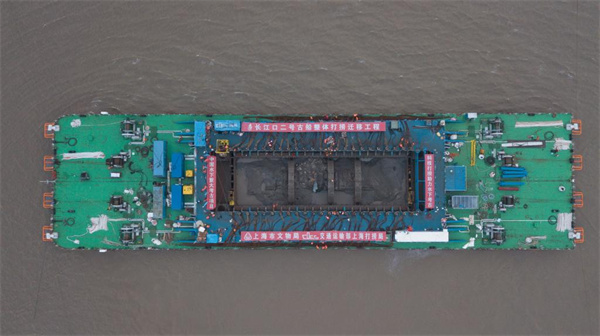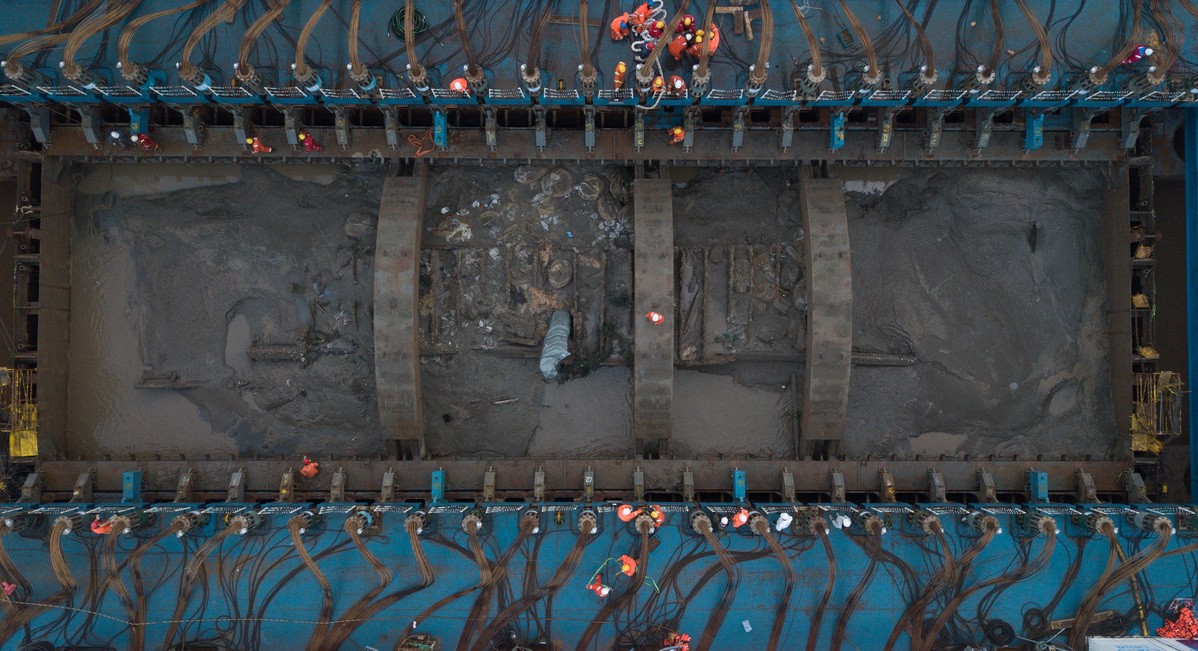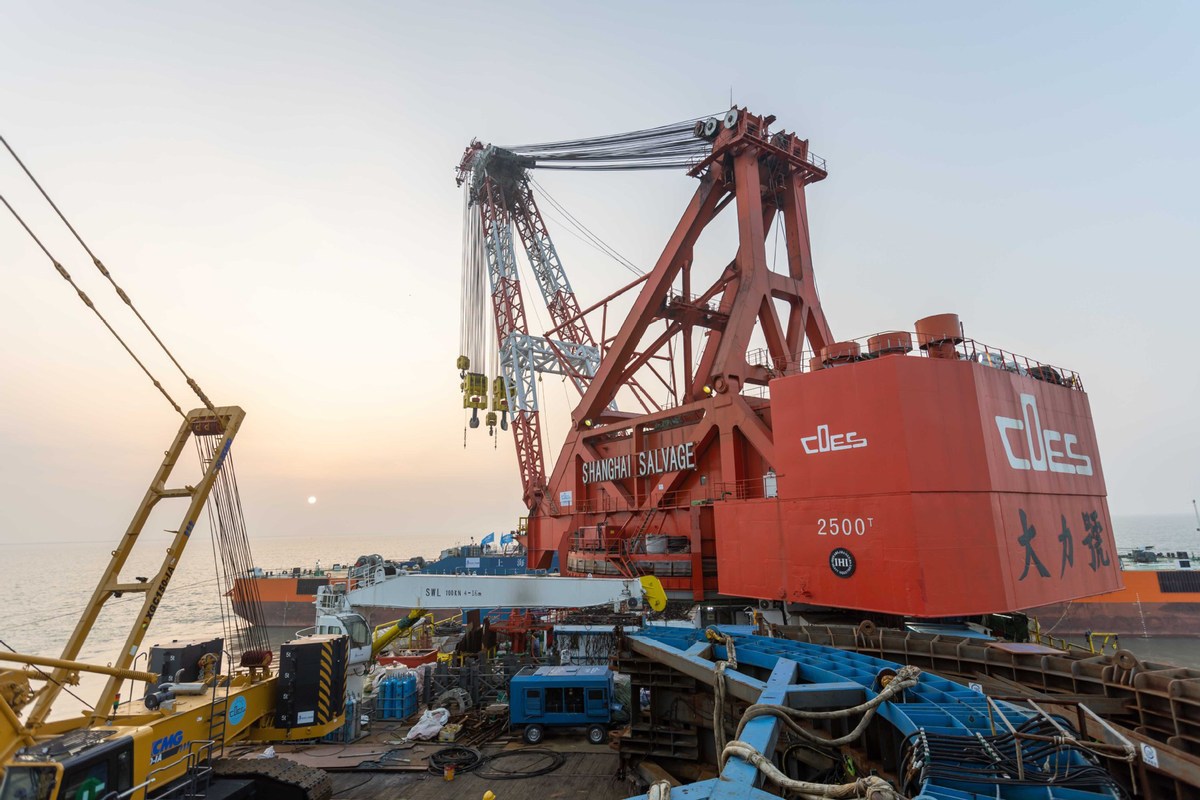High technology plays crucial role in salvage of ancient vessel in Shanghai
Advanced technologies have played a crucial role in the salvage of Yangtze River Estuary No. 2 ancient vessel that was recently lifted out of waters in east China’s Shanghai.

This aerial photo taken on Nov. 21, 2022 shows a view of the salvage operation of the Yangtze No. 2 ancient vessel in Shanghai, east China. (Photo/Xinhua)
The shipwreck was located in the waters of Hengsha Island in Chongming district, Shanghai. The area is at the confluence of the Yangtze River and the East China Sea, where water visibility is practically zero. Underwater excavation in this kind of environment has long been a major challenge around the world.
To solve the problem, the Shanghai Municipal Administration of Cultural Heritage arranged for crossover cooperation between archaeologists and scientists, who independently developed a patented underwater imaging device for murky water as well as technologies and applications related to the use of robots for underwater archaeology.

The Yangtze Estuary No 2 ancient vessel is salvaged in waters near Shanghai on Nov. 21, 2022. (Xinhua/Jin Liwang)
They have also carried out investigations into the waters at the mouth of the Yangtze River using ocean exploration equipment including an unmanned boat, multi-beam sonar, sub-bottom profiler, and magnetometer.
More importantly, the administration worked together with the Shanghai Salvage Company under China’s Ministry of Transport to integrate cutting-edge salvage techniques, technical routes, and equipment manufacturing technologies. They also jointly developed a solution for non-contact overall relocation of cultural relics using arched beams, the first of its kind in the world, to salvage the ancient vessel.

This photo taken on Nov 20, 2022 shows a view of the salvage operation of the Yangtze Estuary No 2 ancient vessel in Shanghai, East China. (Photo/Xinhua)
The ancient vessel was scooped up from the riverbed by 22 giant arched steel beams, which formed a caisson weighing about 8,800 tonnes. The entire caisson, along with the shipwreck inside, was then lifted from the water with synchronized hoisting devices installed on a workboat named Fenli, which was specially designed and built for the salvage operation of the Yangtze River Estuary No. 2 ancient vessel.
The workboat has an open moon pool in its hull. The moon pool is 56 meters long and 20 meters wide, and did a good job in protecting the shipwreck after it was lifted from the riverbed.
The application of cutting-edge technologies in archaeology and the protection of cultural relics for the first time fully demonstrated the integrated development of cultural relics protection and sci-tech innovation, provided new methods, ideas, and examples for underwater archaeology, and offered Chinese experience in underwater archaeology to the rest of the world, said experts.

Photo shows a salvaged porcelain ware. (Photo/National Cultural Heritage Administration)
The wooden vessel was discovered underwater in 2015, and dates back to the reign of Emperor Tongzhi (1862-1875) of the Qing Dynasty (1644-1911). It is 38.1 meters long and 9.9 meters wide, and has 31 cabins. Its hull was buried at a depth of 5.5 meters below the riverbed, and the waters where the shipwreck was discovered are 8 to 10 meters deep.
The vessel was loaded with exquisite cultural relics, including porcelain made in the kilns of Jingdezhen, the world-famous "porcelain capital" in east China's Jiangxi Province, dark-red enameled pottery, and bongs produced in Vietnam.
The discovery and salvage of the ancient vessel marked a milestone in the country’s underwater archaeology and filled a gap in the research into large wooden sailing ships in the late Qing Dynasty, according to experts. The well-preserved vessel and the rich cultural relics inside it are of great significance to research into the history of shipbuilding, shipping, porcelain making, and the economy of China and even the world, they noted.
Since 2016, many institutions in China, including the National Center For Archaeology, have carried out underwater archaeological investigations and interdisciplinary research into the shipwreck every year.
The salvage of the shipwreck began more than 70 days ago, and the underwater hoisting operation lasted more than four hours.
Photos
Related Stories
- China-U.S. joint venture unveils new fleet brand of cruise ships
- Chinese shipbuilding firm starts construction of liquefied carbon dioxide carriers
- China remains world's top shipbuilder in first three quarters
- Chinese tracking vessel sets sail for new missions
- Newly decorated world's largest ro-ro passenger ship unveiled
- 'Five-star hotel at sea'
- World's largest wooden sailing ship moors in Malta en route to Shanghai
- World's largest container ship successfully undocked in Shanghai
- Mega container ship delivered in Shanghai
- China's first unmanned autonomous container ship makes maiden voyage
Copyright © 2022 People's Daily Online. All Rights Reserved.









